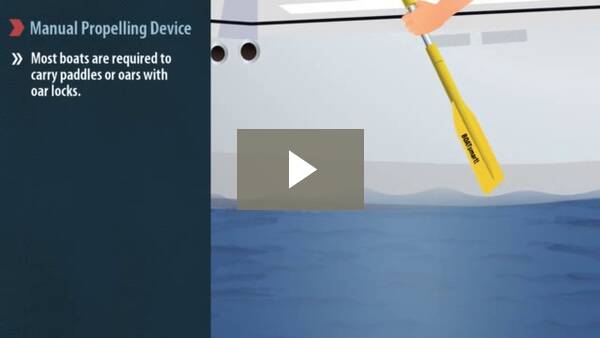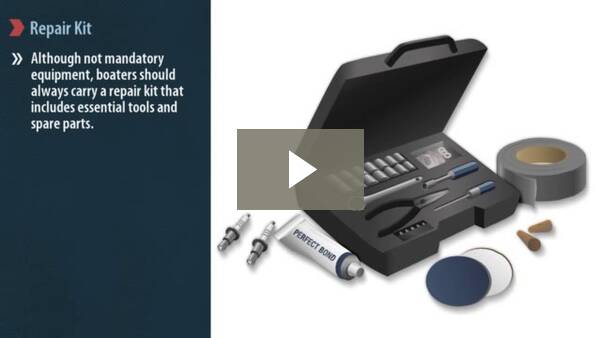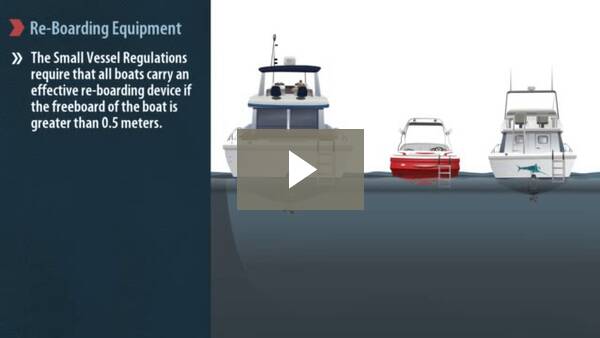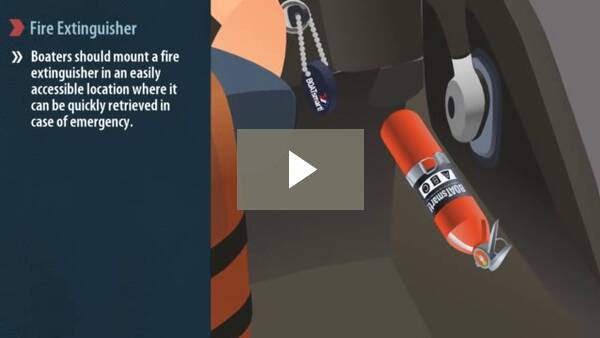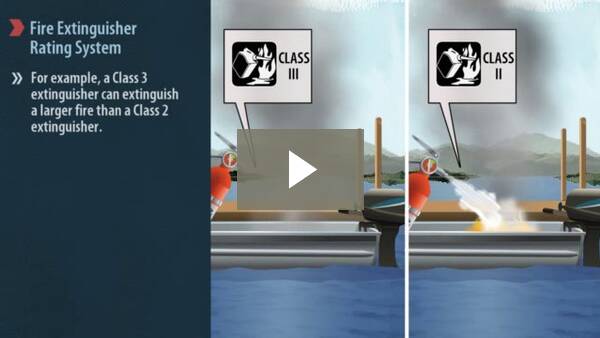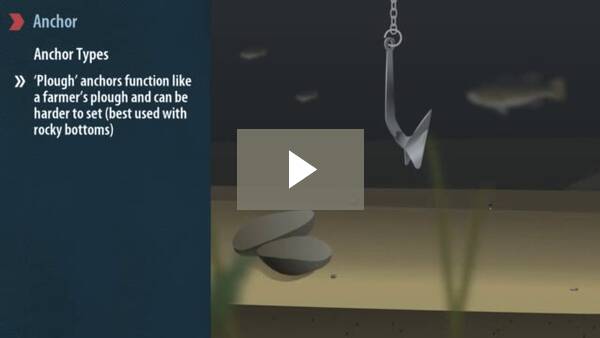Having the required boating safety equipment on your boat at all times is not only required but will also help you respond well if you find yourself in an emergency situation. The important part of your boating safety equipment is learning how to use it and being sure to maintain it or keep it in good working order. Here’s a breakdown of some of the boating safety equipment that’s good to have on hand.
- Bailing devices
- Manual and electric bilge pumps
- Anchor
- Manual propelling devices (oars/paddles)
- Axe
- Repair kit
- Life Buoy
- Fire extinguisher
- Re-boarding device (ladder)
Safe Boating Tip: It’s a good idea to store all your safety equipment in a duffle bag or container. Keeping it readily accessible and available ensures you’ll find it when you need it most!
Bailing Device
A bailing device is used to remove water from inside a boat. The Small Vessel Regulations require bailers to:
- Be made of metal or plastic
- Have a volume of at least 750 ml and an opening that is at least 65 cm2 in area
Buckets
A bucket is a type of bailing device. It can be used to fight fires and dispel water from your boat.
- Motorized boats 12m in length and longer are required to carry two buckets with a 10L minimum capacity
- Motorized boats over 20m in length are required to carry four buckets with a 10L minimum capacity
Life Buoy
A life buoy (sometimes called a life ring) is a device that can be used to rescue a person who has fallen overboard. To be approved, a life buoy must have no tears, perforations or rot and the gridlines must be secure and in good condition.
A life buoy is required to:
- Be circular in shape
- Have an outside diameter of either 610 mm or 762 mm
- Carry a sticker indicating that it has been approved by Transport Canada
- Be attached to a line of at least 15 m in length and appropriate for the size of your vessel
Manual and Electric Bilge Pumps
A bilge pump is a pump that can be used to remove water from the lowest point of a boats interior hull. There are two different types:
Manual bilge pumps
If using a manual bilge pump to dispel water from the boat, you must ensure the discharge hose is long enough to reach from the bilge to over the side of your boat.
Electric bilge pumps
Electric bilge pumps are designed to remove water from the hull of a vessel. Some electric bilge pumps will turn on automatically if the water level in the bilge begins to rise. Boats fitted with electric bilge pumps are recommended to carry a manual pump or bailing device as a back-up in case of a mechanical failure.
Manual Propelling Device
Manual propelling devices can be used to manoeuver your boat in the case of a breakdown. Most boats are required to carry paddles or oars with oar locks. If operating a boat less than 8m in length you may use an anchor with a minimum of 15m of rope, cable or chain in place of a manual propelling device.
Axe
Those operating large boats (longer than 12m in length) must carry one axe onboard at all times. An axe must be protected from the elements and kept in an easily accessible location. It can be used to chop into a wall that is concealing open flames or to cut a towline in an emergency.
Repair Kit
Although not mandatory equipment, boaters should always carry a repair kit that includes essential tools and spare parts. Tapered wooden plugs, underwater sealing compounds, patch kits and duct tape can all be used to help stop hull leaks.
Re-Boarding Equipment
A re-boarding device, such as a transom or swim platform ladder appropriate to the size of the vessel, is designed to allow easy re-boarding of your boat from the water. The Small Vessel Regulations require that all boats carry an effective re-boarding device if the Freeboard of the boat is greater than 0.5 m. A re-boarding device cannot be part of the propulsion unit.
Fire Extinguisher
Fire extinguishers are required onboard any boats with a motor and any one of the following:
- Closed compartments where portable fuel tanks may be stored
- Closed living and cooking spaces
- Permanently installed fuel tanks
- Enclosed engine compartments
Boaters should mount a fire extinguisher in an easily accessible location where it can be quickly retrieved in case of emergency. Though not required for all motorboats, it is highly recommended that every operator in a motorized boat carry a fire extinguisher.
Safe Boating Tip:Fire extinguishers must be approved by the Underwriters Laboratories of Canada (ULC), the Underwriters Laboratory (UL) or the U.S. Coast Guard (USCG).
Fire Extinguisher Rating System
Fire extinguishers are rated using a system of letters and numbers:
- Class A: Designed for use on combustible solid materials such as wood and paper
- Class B: Designed for use on combustible liquid fires including gas, oil and grease
- Class C: Designed for use on electrical fires
The number identifies the amount of agent (material that puts out the fire) that is inside the extinguisher. The higher the number, the greater the amount of fire-fighting agent in the device. For example, a Class 3 extinguisher can extinguish a larger fire than a Class 2 extinguisher.
The Small Vessel Regulations require that Class BC extinguishers be used on boats in Canada. However, the use of a Class ABC fire extinguisher is recommended. Ensure that the fire extinguisher you choose meets the requirements for the size and type of your boat. Remember, even if your boat is equipped with an automatic extinguishing system, you still must carry portable fire extinguishers.
Anchor
An anchor can be used during an engine failure emergency or during bad weather to keep you from drifting towards obstacles. If operating a boat 9m in length or longer you are required to carry an anchor. The Small Vessel Regulations also require that an anchor be fitted with at least 15, 30 or 50m of cable, rope or chain in any combination (the length depends on your boat).
Anchor types:
- ‘Fisherman’ anchors are a non-burying type with one arm that penetrates the bottom. They are best used for rocky bottoms.
- ‘Fluke’ anchors, also known as ‘Danforth’ anchors, have pointed flukes that dig into the ground. They are best used for grass and mud.
- ‘Plough’ anchors function like a farmer’s plough and can be harder to set. They are best used with rocky bottoms.
- ‘Bruce’ or ‘Claw’ anchors are popular for small boats because they set easily and tend to maintain their hold during changes in wind and tide. They are best used in most waterway bottoms making them a popular type of anchor.
Choosing the right anchor depends on the size and weight of your boat and the characteristics of the waterways bottom (i.e. sand, rock or mud). Larger anchors are recommended for adverse conditions and those equipped with a shackle pin should have a locking device.
Remember to securely fasten the end of your Anchor Line to the bow of your boat and to securely attach the outboard end of the anchor line to the anchor!
Now that we have a good understanding of the different pieces of safety equipment needed on board, it’s important to know that different sizes and types of boats are required to carry different equipment. To take a closer look at the necessities for each watercraft, refer to Safety Requirements by Boat Type to know exactly what you need onboard.






